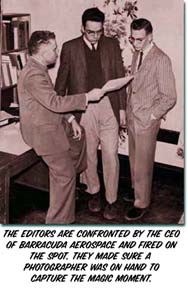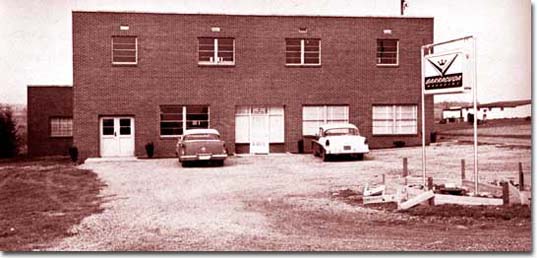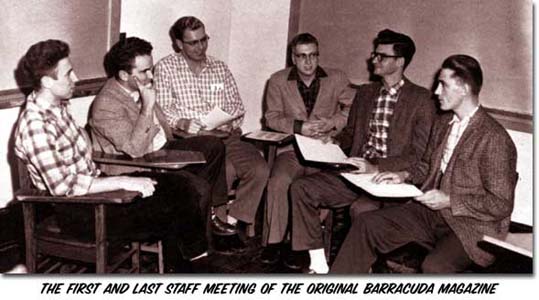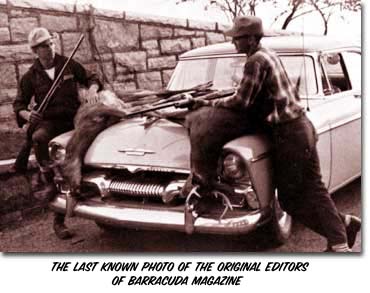The History Of Barracuda
Barracuda was officially started as a magazine in 1961. Originally, it was intended to be the company publication for the now-defunct Barracuda Aerospace Engineering corporation based in Long Beach, California.

The job of creating the company publication was given to Marty Fox and Charlie Saeufer. Marty was a bright, young engineer who was a recent graduate of Cal Poly. He had been aggressively recruited by Barracuda Aerospace to work in their engineering department. He showed great promise as an engineer, which is why he resented being charged with a task as mundane as producing the company newsletter so much. He had been fielding offers from other aerospace firms in Seattle, so he used the newsletter to try to get himself fired and cash in on his lucrative severance package.
Charlie Saeufer was a little older and had been in on the ground floor of Barracuda Aerospace, but he was generally known as a sour old crackpot and decided to go along with Marty’s plan.
 The two had been directed to use the publication to feature engineering issues, production reports and optimistic articles about the possibilites of the burgeoning aerospace industry.
The two had been directed to use the publication to feature engineering issues, production reports and optimistic articles about the possibilites of the burgeoning aerospace industry.
But rather than producing a traditional corporate newsletter, the two took the money in the budget and used it to create a publication featuring nude girlie pin-ups, car repair tips and 56 pages of listings comparing booze prices at every liquor store in Los Angeles and Orange County.
Of course, there was also a good dose of Saeufer’s trademark paranoid ranting in the magazine. This included conspiracy theories about collusion between the U.N. and the Pope, a feature on numerology, as well as slanderous, unfounded accusations about every person in the company’s employ from the janitor to the CEO and primary stockholders.
Their plan worked with tremendous efficiency. As soon as the publication hit the CEO’s desk, the two were fired. But they had already printed 40,000 copies of the magazine on Barracuda Aerospace’s dime. Not the types to see so much work go to waste, the editors took the magazines to local newsstands, liquor stores and dog tracks, leaving big piles of them for people to take for free.
[dropcap]A[/dropcap]s dumb luck would have it, the two had actually hit on a very successful formula. The magazine was hugely popular. That era, after all, was the heyday of stag magazines. Barracuda became somewhat of a cult hit. When the magazine was featured on Jack Harrison’s short-lived local TV show “The Stag Society,” the two were deluged with fan mail and photos of Hollywood starlets who wanted to be featured in the magazine’s pin-ups.
They decided to give up engineering altogether. They went into business together to produce Barracuda Magazine and opened up a production office in Burbank, California.

An editorial staff was assembled consisting of Charlie’s unemployable army buddies and Barracuda was on its way. Only one staff meeting was held, in which Marty and Charlie announced that they were suspending production of the magazine until after hunting season.

Unfortunately, the two never returned from their hunting trip. Their car was found abandoned in the mountains with two deer strapped to the hood and the engine running. There were two sets of footprints in the snow, which lead into some nearby woods, but no one was able to find the men. Neither Marty nor Charlie was ever seen again and the potential of Barracuda Magazine was left unrealized.

In 1998, the heirs of these two cranks, Jeff Fox and Smitty Saeufer, decided to relaunch the magazine as a tax dodge for their successful asbestos removal business and Barracuda was reborn.
The magazine once again became popular and successful, bringing pin-ups, ramblings about frugality and crackpot sociology to a whole new generation of readers, fulfilling the greatest dreams of its long-lost creators.
Barracuda publisher Jeff Fox has since started Barracuda Radio. On the show, artisans and artists talk about the rewards of following their passion and marching to the beat of their own drummer. This is a theme that Fox holds dear to his heart, as the show is recorded largely from his state of near-total seclusion in a walled compound near the Salton Sea.